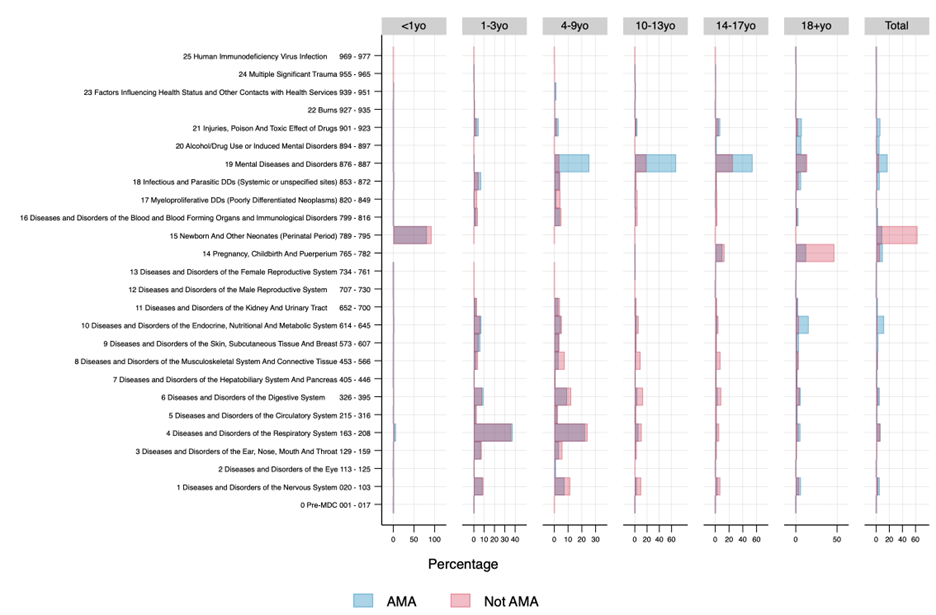Back
Background: Shared decision-making in pediatrics involves a nuanced discussion between patients, families, and healthcare providers. When hospitalized pediatric patients leave against medical advice (AMA), this may reflect a communication breakdown among stakeholders. The extent to which patients directly engage in their care decisions, including leaving AMA, is affected by age, developmental capacity, and diagnostic trajectory. Current literature on drivers of leaving AMA is limited and has not explored how age or diagnoses may impact this disposition.
Objective: To assess the age-stratified diagnostic distribution of hospitalized pediatric patients who leave AMA.
Design/Methods: We reviewed data from the 2016 and 2019 Kids’ Inpatient Database of pediatric hospital discharges resulting in leaving AMA. Using weighted summary statistics, we analyzed the distribution of major diagnostic categories (MDC) of patients who left AMA. The top three MDCs were identified across all ages and for age categories: < 1 year old, 1-3 years old, 4-9 years old, 10-13 years old, 14-17 years old, and >18 years old (Table 1).
Results: Figure 1 shows the age-stratified diagnostic distribution for patients who did and did not leave AMA. Across all ages of patients leaving AMA, the top three MDCs were Mental Disease & Disorders (MDD) (17%), Endocrine, Nutritional & Metabolic Diseases & Disorders (ENMDD) (12%), and Pregnancy, Childbirth, and Puerperium (10%). MDD was the top MDC for patients leaving AMA for 4-9 years, 10-13 years, and 14-17 years, and was third for >18 years. ENMDD was the top MDC for >18 years and was third for < 1 year. Diseases of the Respiratory System was the top MDC for 1-3 years. Newborns and Other Neonates with Conditions Originating in Perinatal Period was the top MDC for < 1 year.
Conclusion(s): Our study revealed that mental health disorders, endocrinological/nutritional diseases, and pregnancy-related conditions are overrepresented among pediatric patients who leave AMA. Mental health conditions were predominant among adolescents who left AMA, an age during which patients may be more vocal in their own medical care. Goals for safe discharge may be harder to define, especially with insufficient availability of pediatric behavioral services. These top diagnoses may have prolonged hospitalizations that can be difficult to balance with competing priorities outside the hospital. These clinical scenarios may be frustrating, possibly leading to dissatisfaction and requesting to leave AMA. Further research is needed to understand this diagnostic distribution and to explore age-related differences in deciding to leave AMA.
Figure 1: Percent Distribution of Major Diagnostic Categories Among Hospitalized Pediatric Patients Leaving Against Medical Advice Stratified by Age
 Mental Diseases & Disorders were the most common MDC across all total ages of patients who left AMA and are overrepresented among those aged 4-9 years, 10-13 years, and 14-17 years. Endocrine, Nutritional & Metabolic Diseases & Disorders were second most common across all total ages with highest representation within the >18 year old category.
Mental Diseases & Disorders were the most common MDC across all total ages of patients who left AMA and are overrepresented among those aged 4-9 years, 10-13 years, and 14-17 years. Endocrine, Nutritional & Metabolic Diseases & Disorders were second most common across all total ages with highest representation within the >18 year old category.
Table 1: Age-Stratified Distribution of Top Three Major Diagnostic Categories Among Patients Leaving Against Medical Advice

Hospital Medicine 6: Clinical
Session: Hospital Medicine 6: Clinical
537 - Age-Stratified Distribution of Chief Diagnoses Among Hospitalized Pediatric Patients Who Leave Against Medical Advice
Sunday, April 27, 2025
8:30am – 10:45am HST
Rita Wang, Boston Children's Hospital, Boston, MA, United States; Destiny Tolliver, Boston University School of Medicine, Boston, MA, United States; Yuan He, Perelman School of Medicine at the University of Pennsylvania, Philadelphia, PA, United States; Anthony J. Mell, Boston University School of Medicine, Boston, MA, United States; Patrice Melvin, Boston Children's Hospital, Boston, MA, United States; Valerie L.. Ward, Boston Children's Hospital, Boston, MA, United States; Jay Berry, Complex Care, Boston Children's Hospital, Boston, MA, United States; Jeffrey Campbell, Boston Medical Center, Boston, MA, United States

Rita Wang, MD (she/her/hers)
Resident Physician
Boston Children's Hospital / Boston Medical Center
Boston, Massachusetts, United States
Presenting Author(s)
Background: Shared decision-making in pediatrics involves a nuanced discussion between patients, families, and healthcare providers. When hospitalized pediatric patients leave against medical advice (AMA), this may reflect a communication breakdown among stakeholders. The extent to which patients directly engage in their care decisions, including leaving AMA, is affected by age, developmental capacity, and diagnostic trajectory. Current literature on drivers of leaving AMA is limited and has not explored how age or diagnoses may impact this disposition.
Objective: To assess the age-stratified diagnostic distribution of hospitalized pediatric patients who leave AMA.
Design/Methods: We reviewed data from the 2016 and 2019 Kids’ Inpatient Database of pediatric hospital discharges resulting in leaving AMA. Using weighted summary statistics, we analyzed the distribution of major diagnostic categories (MDC) of patients who left AMA. The top three MDCs were identified across all ages and for age categories: < 1 year old, 1-3 years old, 4-9 years old, 10-13 years old, 14-17 years old, and >18 years old (Table 1).
Results: Figure 1 shows the age-stratified diagnostic distribution for patients who did and did not leave AMA. Across all ages of patients leaving AMA, the top three MDCs were Mental Disease & Disorders (MDD) (17%), Endocrine, Nutritional & Metabolic Diseases & Disorders (ENMDD) (12%), and Pregnancy, Childbirth, and Puerperium (10%). MDD was the top MDC for patients leaving AMA for 4-9 years, 10-13 years, and 14-17 years, and was third for >18 years. ENMDD was the top MDC for >18 years and was third for < 1 year. Diseases of the Respiratory System was the top MDC for 1-3 years. Newborns and Other Neonates with Conditions Originating in Perinatal Period was the top MDC for < 1 year.
Conclusion(s): Our study revealed that mental health disorders, endocrinological/nutritional diseases, and pregnancy-related conditions are overrepresented among pediatric patients who leave AMA. Mental health conditions were predominant among adolescents who left AMA, an age during which patients may be more vocal in their own medical care. Goals for safe discharge may be harder to define, especially with insufficient availability of pediatric behavioral services. These top diagnoses may have prolonged hospitalizations that can be difficult to balance with competing priorities outside the hospital. These clinical scenarios may be frustrating, possibly leading to dissatisfaction and requesting to leave AMA. Further research is needed to understand this diagnostic distribution and to explore age-related differences in deciding to leave AMA.
Figure 1: Percent Distribution of Major Diagnostic Categories Among Hospitalized Pediatric Patients Leaving Against Medical Advice Stratified by Age
 Mental Diseases & Disorders were the most common MDC across all total ages of patients who left AMA and are overrepresented among those aged 4-9 years, 10-13 years, and 14-17 years. Endocrine, Nutritional & Metabolic Diseases & Disorders were second most common across all total ages with highest representation within the >18 year old category.
Mental Diseases & Disorders were the most common MDC across all total ages of patients who left AMA and are overrepresented among those aged 4-9 years, 10-13 years, and 14-17 years. Endocrine, Nutritional & Metabolic Diseases & Disorders were second most common across all total ages with highest representation within the >18 year old category.Table 1: Age-Stratified Distribution of Top Three Major Diagnostic Categories Among Patients Leaving Against Medical Advice


